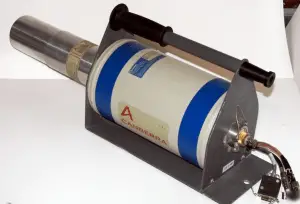
High-purity germanium detectors (HPGe detectors) are the best solution for precise gamma and x-ray spectroscopy. Compared to silicon detectors, germanium is much more efficient than silicon for radiation detection due to its atomic number being much higher than silicon and lower average energy necessary to create an electron-hole pair, which is 3.6 eV for silicon and 2.9 eV for germanium. Due to its higher atomic number, Ge has a much larger linear attenuation coefficient, which leads to a shorter mean free path. Moreover, silicon detectors cannot be thicker than a few millimeters. At the same time, germanium can have a depleted, sensitive thickness of centimeters and, therefore, can be used as a total absorption detector for gamma rays up to a few MeV.
The HPGe detectors must operate at very low temperatures of liquid nitrogen (-196°C) to achieve maximum efficiency because, at room temperatures, the noise caused by thermal excitation is very high.
HPGe Detector – Principle of Operation
The operation of semiconductor detectors is summarized in the following points:
- Ionizing radiation enters the detector’s sensitive volume (germanium crystal) and interacts with the semiconductor material.
- A high-energy photon passing through the detector ionizes the atoms of the semiconductor, producing electron-hole pairs. The number of electron-hole pairs is proportional to the energy of the radiation to the semiconductor. As a result, many electrons are transferred from the valence band to the conduction band, and an equal number of holes are created in the valence band.
- Since germanium can have a depleted, sensitive thickness of centimeters, it can absorb high-energy photons totally (up to a few MeV).
- Under the influence of an electric field, electrons and holes travel to the electrodes, resulting in a pulse that can be measured in an outer circuit.
- This pulse carries information about the energy of the original incident radiation. The number of such pulses per unit time also gives information about the intensity of the radiation.
In all cases, a photon deposits a portion of its energy along its path and can be absorbed totally. Total absorption of a 1 MeV photon produces around 3 x 105 electron-hole pairs. This value is minor compared to the total number of free carriers in a 1 cm3 intrinsic semiconductor. Particle passing through the detector ionizes the atoms of the semiconductor, producing the electron-hole pairs. But in germanium-based detectors at room temperature, thermal excitation is dominant. It is caused by impurities, structure lattice irregularities, or dopants. It strongly depends on the Egap (a distance between valence and conduction band), which is very low for germanium (Egap= 0.67 eV). Since thermal excitation results in the detector noise, active cooling is required for some types of semiconductors (e.g., germanium).
![]() Note that a 1 cm3 sample of pure germanium at 20 °C contains about 4.2×1022 atoms but also contains about 2.5 x 1013 free electrons and 2.5 x 1013 holes constantly generated from thermal energy. As can be seen, the signal-to-noise ratio (S/N) would be minimal (compare it with 3 x 105 electron-hole pairs). Adding 0.001% of arsenic (an impurity) donates an extra 1017 free electrons in the same volume, and the electrical conductivity is increased by a factor of 10,000. The signal-to-noise ratio (S/N) would be even smaller in doped material. Because germanium has a relatively low band gap, these detectors must be cooled to reduce the thermal generation of charge carriers (thus reverse leakage current) to an acceptable level. Otherwise, leakage current-induced noise destroys the energy resolution of the detector.
Note that a 1 cm3 sample of pure germanium at 20 °C contains about 4.2×1022 atoms but also contains about 2.5 x 1013 free electrons and 2.5 x 1013 holes constantly generated from thermal energy. As can be seen, the signal-to-noise ratio (S/N) would be minimal (compare it with 3 x 105 electron-hole pairs). Adding 0.001% of arsenic (an impurity) donates an extra 1017 free electrons in the same volume, and the electrical conductivity is increased by a factor of 10,000. The signal-to-noise ratio (S/N) would be even smaller in doped material. Because germanium has a relatively low band gap, these detectors must be cooled to reduce the thermal generation of charge carriers (thus reverse leakage current) to an acceptable level. Otherwise, leakage current-induced noise destroys the energy resolution of the detector.